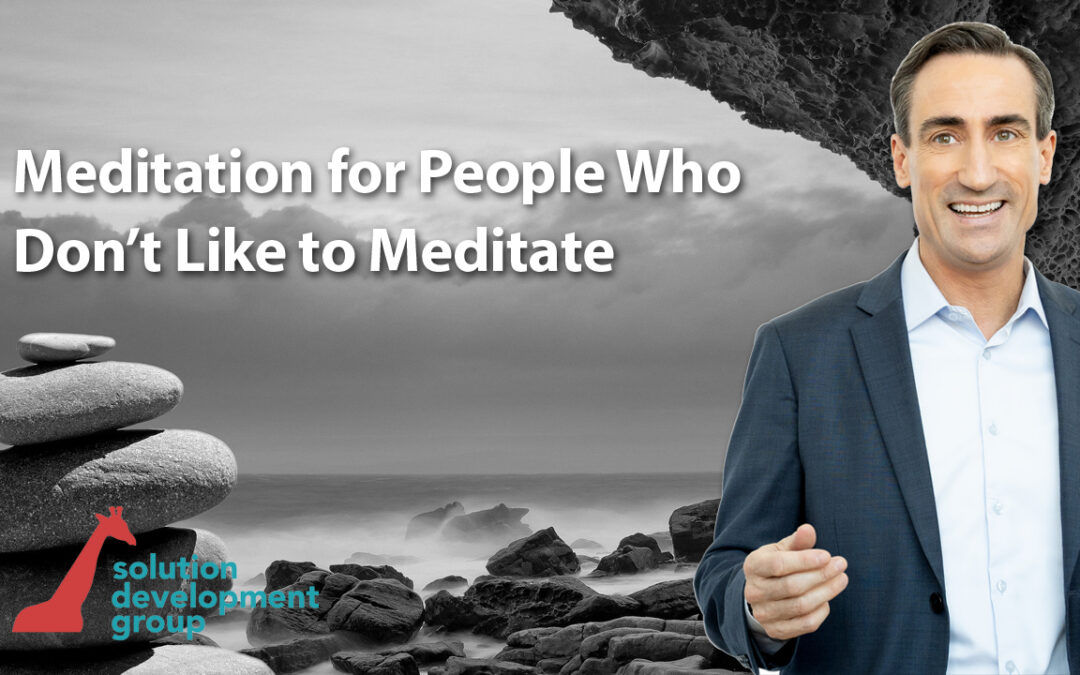One effective way to strengthen your resilience is through meditation.
But not everyone thinks they are cut out to meditate.
Which is unfortunate, because there are many great reasons to practice meditation.
For one thing, meditation reduces stress and helps control anxiety.
It can contribute to better self-awareness, which also help your personal and work relationships.
Adopting a meditation practice can help you sleep better. And we all know that if you sleep better, that in the waking hours, you tend to be better at managing emotions and (once again) relationships.
Despite its positive effects on mental and emotional health, many of the people I meet as a keynote speaker at conferences, leadership forums, and corporate events are still hesitant to commit to a meditation practice.
And – believe it or not – I totally get where they’re coming from. The reasons many have to not engage in a meditation practice are often completely valid. Nevertheless, they are missing out on a lot of benefits that meditation has to offer. So, here’s how I try to convince them to reconsider their stance on meditation.
Here are the top 3 reasons clients tell me why they don’t try meditation, and why they should give it a try:
1. “I tried meditation, and it didn’t work.”
I appreciate when people try something like meditation, and it doesn’t yield the results they expect right away, so they quickly move onto other things.
The truth is, what a lot of people don’t realize, is that meditation takes practice.
If it doesn’t work for you the first time, that doesn’t mean it won’t work for you down the road.
Try shifting your idea on what you think it looks like when “meditation is working”.
Sometimes, it’s just feeling calmer during the meditation. Giving yourself a break from a stressful day. “A moment to catch your breath” so to speak.
Sometimes, it’s feeling calmer for 5 or 10 minutes afterwards.
It might even be a moment where you may have a bit of tension with someone and you took a pause and didn’t respond right away – this can also be a benefit of meditation.
So certainly, there’s room to try meditation, if you can shift your version of what “successful meditation” looks like.
2. “Meditation is too complicated.”
The second thing I often hear is that meditation is just too complicated.
I can understand why it might seem overwhelming to a beginner. And, to be honest, maybe it has become over-complicated in many instances.
There are so many resources, books, and videos available to us, and they all have something to add to the conversation.
Even the word, “meditation” has come to mean many different things.
While different spiritual paths may associate meditation with contemplation, prayer, or other practices, Buddhist meditation is generally associated with mindfulness or awareness.
While there are certainly a lot more forms of Buddhist meditation, they all share a common denominator: mindfulness, or awareness.
And the practice of meditation (or mindfulness) is pretty straight forward.
3. “I don’t know how to meditate.”
And finally, the third popular reason I hear is, “I don’t know how to mediate.”
No problem – I’ve got a super straightforward practice I can share here. I’ve done this with individuals, small groups of 5 people, as well as large groups of 300.
It works because it’s as simple as it is effective. This technique takes us away from any complexity.
Ready? Here we go.
Sit comfortably. I sit in a chair when I meditate. See if you can sit with your back straight.
Notice your breath going in and out. Close your eyes if you wish.
You don’t need to control your breath – just observe what it’s doing.
As you notice your breath coming in or going out, you’ll find your mind starts to wander. It might start to make a grocery list. It might start to hear some sounds in the distance and you’ll wonder what those sounds are. It might think about something that you said to someone yesterday and you need to reach out to them and clear that up.
Don’t worry.
When you notice that you’re thinking about something other than your breath, see if you can let the thought go and switch back to observing your breath. Your job in meditation is to notice that thought happening and then bring your thought back to observing your breath.
You’ll notice when you focus on your breath that your mind will wander off again. When it does this, notice it and bring it back to your breath.
That back and forth, bringing your attention back to your breath, is the essence of meditation.
That’s practice.
The practice is bringing your attention back to your breath.
I always think about it as just that – it is a practice. You may get to the point where you can focus on your breath for a minute or two, and then five minutes. I have friends who can go a half hour before their mind wanders off, and it’s all good.
I do about 10 minutes a day, but if you’re trying it out for the first time, just try two or three minutes to start. It will make a difference remembering that it is a practice.
And please, don’t over-complicate it. You can do this in the grocery lineup. You can do this waiting at a red light. At any time, you can just check in with your breath and you’ll watch where your thoughts go and see if you can bring them back. Have some fun with it.
I hope you found this informative. If you’d like to go deeper, check out my “Strengthen Your Resilience” sessions at https://solutiondevelopmentgroup.com/resilience/


Recent Comments